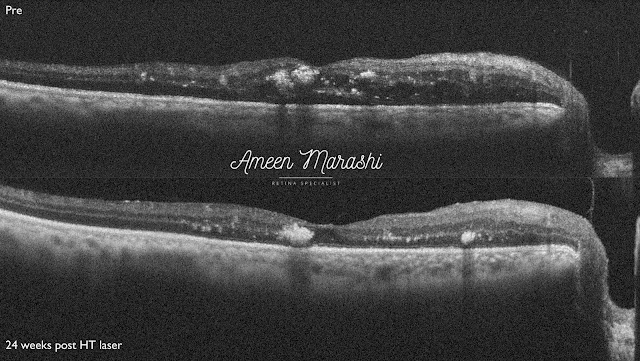Diabetic macular edema in a glaucomatous patient with a history of endophthalmitis treated with HT laser
Sixty-four-year-old pseudophakic known to be diabetic had a history of steroid-induced glaucoma and successfully treated for endophthalmitis with intravitreal antibiotics due to intravitreal Bevacizumab.
His vision is counting fingers with central diabetic macular edema managed with Hybridthrehold laser (HT laser).
After 24 weeks, there is a reduction of central macular thickening and improved vision up to 20/40
 |
| OCT cross-sections before and after treatment with HT laser |
Disclosure HT laser parameters developed by Ameen Marashi.
I am attracted by the presentation of this article. This information about Glaucoma, is really good. I really appreciate your work. It is a gainful article for us. Keep posting. Thank you.
ReplyDeleteLaser treatment for glaucoma
The information you have provided in this post is very helpful as it contains some good knowledge. Thanks for sharing such a great post. Keep Posting. diabetic eye care
ReplyDeleteGreat post, your all points fully clarified all topics by this post. These steps are helpful for online accounting services. Thank you for providing such valuable information.houston retina specialists
ReplyDeleteYou can also check this one and can share your opinions on laser treatment for glaucoma in yorktown
ReplyDeleteIt’s a really useful post for me related eye care services in Croton. Very interesting, good job, and thanks for sharing such an informative post.
ReplyDeleteTherapeutic massages may incorporate a range of techniques such as deep tissue massage, myofascial release, trigger point therapy, and stretching, depending on the client's needs. Therapeutic massage raleigh nc
ReplyDeleteThhis was great to read
ReplyDelete